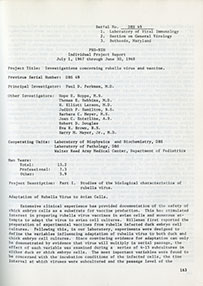
Serial No. DBS 49
1. Laboratory of Viral Immunology
2. Section on General Virology
3. Bethesda, Maryland
PHS-NIH
Individual Project Report
July 1, 1967 through July 30, 1968
Project Title: Investigations concerning rubella virus and vaccine.
Previous Serial Number: DBS 49
Principal Investigator: Paul D. Parkman, M.D.
Other Investigators: Hope E. Hopps, M.S
Thomas E. Hobbins, M.D.
H. Elliott Larson, M.D.
Judith P. Hamilton, B.S.
Barbara C. Meyer, M.S.
Joan C. Enterline, A.B.
Robert Douglas
Eva R. Brown B.S.
Harry M. Meyer, Jr., M.D.
Cooperating Units: Laboratory of Biophysics and Biochemistry, DBS
Laboratory of Pathology, DBS
Walter Reed Army Medical Center, Department of Pediatrics
Man Years:
Total: 13.2
Professional: 7.3
Other: 5.9
Project Description: Part I. Studies of the biological characteristics of rubella virus.
Adaptation of Rubella Virus to Avian Cells.
Extensive clinical experience has provided documentation of the safety of chick embryo cells as a substrate for vaccine production. This has stimulated interest in preparing rubella virus vaccines in avian cells and numerous attempts to adapt the virus to avian cell cultures. Hilleman first reported the preparation of experimental vaccines from rubella infected duck embryo cell cultures. Following this, in our laboratory, experiments were designed to define the variables influencing adaptation of rubella virus to both duck and chick embryo cell cultures. Since convincing evidence for adaptation can only be demonstrated by evidence that virus will multiply in a serial passage, the effect of each variable was examined during a series of 4-15 subcultures i neither duck or chick embryo cells. The most important variables were found to be concerned with the incubation conditions of the infected cells, the time interval at which viruses were subcultured and the passage level of the
163






